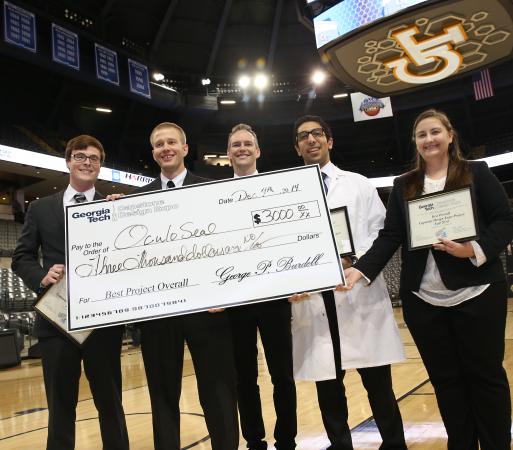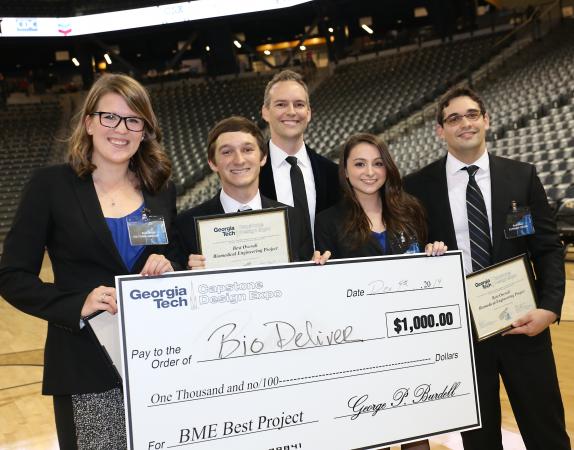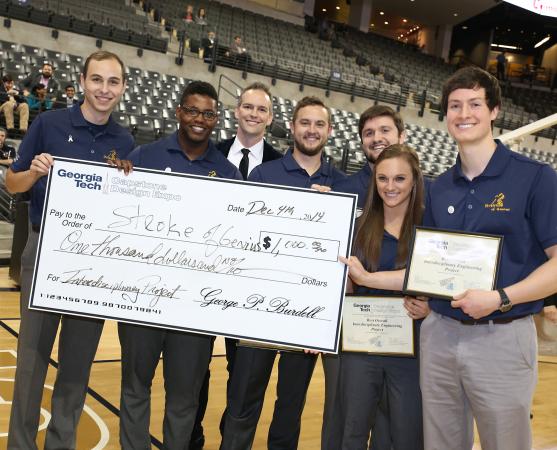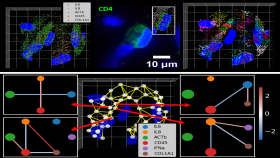Twice every year, senior engineering students at the Georgia Institute of Technology come together for a serious, grown-up version of show-and-tell called the Capstone Design Expo. It’s a judged showcase of innovative solutions, a public unveiling of prototype products designed to address real-world problems.
This year’s fall edition (held December 4 at McCamish Pavilion) featured 106 teams from senior design courses offered across the engineering spectrum at Georgia Tech, including mechanical engineering (ME), electrical and computer engineering (ECE), industrial and systems engineering (ISyE), and industrial design. But it was a team from the Wallace H. Coulter Department of Biomedical Engineering (BME) that took the top prize as overall winner of the Capstone Design Expo.
“Winning this is an incredible honor. It’s humbling, the crowning achievement of my experience at BME and Georgia Tech, independent of winning. It was just a tremendous experience,” says Andy Kolpitcke, lead designer of the winning team, OculoSeal, which included fellow BME seniors Jackie Borinski, Mohamad Ali Najia, and Drew Padilla. “We’ve worked as a group before in some other BME classes and we agreed that we wanted to work in senior design together.”
They designed and created the OculoSTAPLE device, to help in the treatment of ptosis (severely drooping of the upper eyelid), earning the top overall prize of $3,000. It was the highlight of a fruitful evening for BME. A group called Stroke of Genius, which included two BME seniors (Brian Leach and Josh Newton), won the top prize ($1,000) for interdisciplinary teams with their golf cart for children with mobility issues. Capstone winners also were selected from each engineering school or department, and a team called BioDeliver won the BME prize (also $1,000).
Capstone Design, a required semester-long course for all Georgia Tech engineering students, puts teams of seniors together with advisors (who often come from a research or industry environment) to design and build and test prototypes that address a broad range of challenges.
“It starts in August when we receive a sheet of projects that have been thought up by clinicians and a lot of other people, a wide range of things,” Kolpitcke says. “Our team was looking for something that satisfied an unmet clinical need, that would give us experience working with surgeons and observing surgeries, while working on our mechanical design skills.”
That’s how his team linked up with their project sponsor, Dr. Denise Kim, a surgeon at Emory University Hospital who was looking for a better way to repair ptosis. “So we designed a device to meet those clinical needs and change the way a surgeon can perform that procedure,” says Najia, a former Petit Undergraduate Research Scholar. “This was a pressing issue to address, because this is not just a cosmetic procedure. This is a functional issue, especially in the elderly population, who might experience obstruction of vision, which can lead to increased rate of fall-related injuries.”
OculoSeal’s team members met with Dr. Kim, and witnessed two surgeries over the course of the semester, and what they saw was a difficult, time-consuming procedure that can be cosmetically risky for patients. So they created the OculoSTAPLE device, which simultaneously resects and seals the muscle responsible for elevating the upper eyelid, shortening the time it takes to perform the surgery while mitigating the risk. OculoSTAPLE also has potential applications for aparoscopic, gastrointestinal and biopsy procedures.
Meanwhile, the BioDeliver team of Victoria Geisler, Tarrah Herrmann, Esteban Ongini and Steven Touchton (advissponsored by Dr. Ramsey Kinney at Emory), were recognized for developing a biologic delivery system intended to deliver, “growth factors and nutrients that the body needs to heal itself, to the orthopedic injury site during surgery,” according to Geisler, who plans to work in research and development in industry following her graduation this month. “The beauty of our device is, it’s simple and we’re not trying to convince the surgeon to change his procedure, only improving his patients’ ability to heal and their speed of recovery.”
The golf cart designed by the interdisciplinary Stroke of Genius teammates answers a challenge from their sponsors, the Bobby Jones Foundation, Chiari & Syringomyelia Foundation and cart manufacturer E-Z-GO. They want to develop a golf cart that opens the game up to younger players with mobility challenges.
“We learned about the idea through an email over the summer, a blast to all students,” says Newton, recalling how he and Leach got involved in the multifaceted project. “Basically, the email asked, ‘are you interested in sports, in golf in particular, and in working with children who have disabilities?’ Sports. Golf. Kids with disabilities. Those were the key words that caught our attention.”
Newton and Leach were part of an all-star interdisciplinary team that included Tre’vorski Garrett, Katilin Kates and Douglas Wisser from ME, and Jeffrey Pettyjohn from ECE. The team met with young wheelchair athletes, asked what they wanted and needed in such a device. The student engineers also considered issues such as material selection, safety factors and swing positioning. “The responses we got were so important,” Newton says. “What it comes down to is, they want to play with Mom and Dad, and they want the cart to be so cool that everybody would want to use it, including their able-bodied friends.”
The team drew up 20 to 25 different design concepts until before deciding on a two-person cart that was both functional and cool enough to meet the needs of a discerning potential clientele. In the end, besides being a required project that received the accolades of Capstone Expo judges (faculty, industry professionals, etc.), the experience was also a labor of love for Newton and Leach. “We’re both avid golfers,” Newton says.
Capstone Design gives students a chance to utilize the engineering design process to create something tangible in response to real-world, open-ended problems. Teams have a $500 budget to develop their prototypes, with thoughts of eventual commercialization. The program is a foundational piece in a growing emphasis on entrepreneurship education at BME and Georgia Tech.
“That’s a big focus for us now, to create an avenue to pursue these kinds of projects further, no matter where they come from, the classroom or outside the classroom,” says James Rains, director of the BME Capstone Design program.
The real value of the Expo may be the exposure each of these teams receive, and the experience of meeting with industry leaders, clinicians, and the other teams. “The Expo lets us show off our product and move forward with it toward commercialization,” says Najia. “That’s the real benefit, seeing the other teams and their concepts, talking with people from a diverse array of backgrounds.”
The noisy arena was filled with representatives from industry, people engaged in the development of medical devices, professors, volunteers, families, not unlike a festival atmosphere. It was show time: the culmination of the undergraduate experience for some, like Najia and Geisler and Newton, who are graduating this month; or a revelatory peak moment for others, like Kolpitcke, who acknowledges that developing a cutting-edge biomedical solution in the span of a semester was not easy.
“I had a limited amount of time to walk around and see all the other stuff people worked on, and it was a great experience,” says Kolpitcke, who graduates in the spring. “The golf cart, the BioDeliver device – to see the result of all of the hard work that all of the students put in was inspiring, and something you don’t see on a day to day basis here because sometimes, Tech can be demanding and demoralizing. But this was the ‘Aha Moment’ for me, when I realized how special this was. Any time you take on a challenge like the one we took on, there is going to be conflict. As a team, we were able to work through the conflicts and the issues, divide up our roles and leverage our skills to come up with a solution, and even if we hadn’t won the overall prize, that’s something we can be proud of.”
Contact:
Jerry Grillo
Communications Officer II
Parker H. Petit Institute for
Bioengineering and Bioscience
Media Contact
Jerry Grillo
Communications Officer II
Parker H. Petit Institute for
Bioengineering and Bioscience
Keywords
Latest BME News
Commercialization program in Coulter BME announces project teams who will receive support to get their research to market.
Courses in the Wallace H. Coulter Department of Biomedical Engineering are being reformatted to incorporate AI and machine learning so students are prepared for a data-driven biotech sector.
Influenced by her mother's journey in engineering, Sriya Surapaneni hopes to inspire other young women in the field.
Coulter BME Professor Earns Tenure, Eyes Future of Innovation in Health and Medicine
The grant will fund the development of cutting-edge technology that could detect colorectal cancer through a simple breath test
The surgical support device landed Coulter BME its 4th consecutive win for the College of Engineering competition.
New research from Georgia Tech helps doctors predict how therapies will interact with a child's immune system, potentially improving outcomes and reducing risks.










